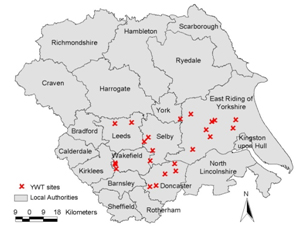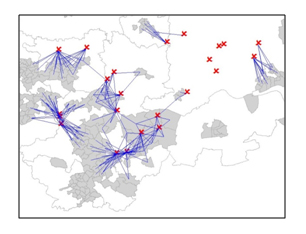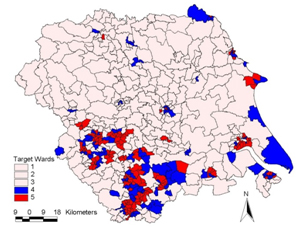Background
The Yorkshire Wildlife Trust (YWT) is a registered charity which exists due to funds from, for example, the People’s Postcode Lottery. Like many outdoor organisations including the National Parks, the YWT was aware that visitors to its sites were in main middle and higher social groups and of White ethnicity. The YWT therefore wished to make a funding application to set up a project to increase visitor numbers from a wider range of backgrounds. Paul Norman at the School of Geography, University of Leeds helped determine a set of target locations for the YWT to aim at to attract people to their wildlife reserves.
Data and Method
A set of population characteristics were defined after discussion and obtained from the 2001 Census for all CAS (Census Area Statistics) wards in Yorkshire & The Humber. These area characteristics included counts to represent (overlapping) elements relating to deprivation (assumed lack of resources), mobility challenges (no car / long-term illness), ethnic minorities.
Unemployed Persons
Non-White Persons
Non-Home owners
Overcrowded Households
Households without Access to a Car
Persons reporting a Limiting Long-Term Illness These dimensions were combined into an index with the resulting scores classified into quintiles. Wards in quintiles 4 and especially 5 were considered to be wards for YWT to target to attract visitors.
Fig 1 - YWT wildlife reserve locations

Download this image Fig 1 - YWT wildlife reserve locations
.jpg (35.9 kB)
Fig 3 - Linking YWT wildlife reserves and target wards

Download this image Fig 3 - Linking YWT wildlife reserves and target wards
.jpg (36.3 kB)Result
The YWT successfully applied for funding from the Heritage Lottery Fund to improve access to twelve nature reserves and the scheme saw people brought to reserve locations by coach from various of the target wards. The success of the scheme was appraised by YWT and by a Leeds student who interviewed participants as part of her BA dissertation.
Census importance
The data analysis used to underpin the grant application was enabled by ready access to small area census data and the range of attribute data at small area level was paramount. The data quality was trusted by the YWT.
Could this have been achieved using alternative data sources?
To some extent the input variables could have been from administrative data but lack of car access would need DVLA data to be available and small area data on ethnicity is currently a challenge. Admin sources might not have been trusted as much as census data.

